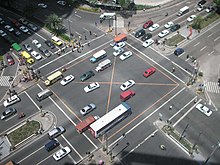
Back هندسة المرور Arabic ئەندازیاریی ھاتوچۆ CKB Verkehrstechnik German Ingeniería de tráfico (transporte) Spanish Trafiko-ingeniaritza Basque مهندسی ترافیک (حملونقل) Persian Teknik lalu lintas ID Ingegneria del traffico Italian 通信トラヒック工学 Japanese Замын хөдөлгөөний инженерчлэл Mongolian

Traffic engineering is a branch of civil engineering that uses engineering techniques to achieve the safe and efficient movement of people and goods on roadways. It focuses mainly on research for safe and efficient traffic flow, such as road geometry, sidewalks and crosswalks, cycling infrastructure, traffic signs, road surface markings and traffic lights. Traffic engineering deals with the functional part of transportation system, except the infrastructures provided.
Traffic engineering is closely associated with other disciplines:
- Transport engineering
- Pavement engineering
- Bicycle transportation engineering
- Highway engineering
- Transportation planning
- Urban planning
- Human factors engineering
Typical traffic engineering projects involve designing traffic control device installations and modifications, including traffic signals, signs, and pavement markings. However, traffic engineers also consider traffic safety by investigating locations with high crash rates and developing countermeasures to reduce crashes. Traffic flow management can be short-term (preparing construction traffic control plans, including detour plans for pedestrian and vehicular traffic) or long-term (estimating the impacts of proposed commercial and residential developments on traffic patterns). Increasingly, traffic problems are being addressed by developing systems for intelligent transportation systems, often in conjunction with other engineering disciplines, such as computer engineering and electrical engineering. Traffic engineers also set a [[design speed] for roads, and sometimes collect data that sets the legal speed limit, such as when the 85th percentile speed method is used.
© MMXXIII Rich X Search. We shall prevail. All rights reserved. Rich X Search